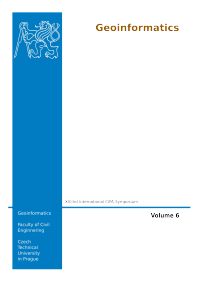“GEOHeritage” - GIS Based Application for Movable Heritage
DOI:
https://doi.org/10.14311/gi.6.28Keywords:
digital heritage, web GIS, archives, public access, on-line mapAbstract
The paper will present the results of a research project „A methodology for mapping movable heritage”. This project, financed by the Polish Ministry of Science and Higher Education in 2008-2010, was realized by the Institute of Geodesy and Cartography in cooperation with the Research and Academic Computer Network (portal Polska.pl), the Central Archives of Historical Records and Department of Art History of the Wroclaw University. The idea of the project was to simplify access to digital movable cultural heritage by the use of spatial information. The main aspect of the project was to use a Geographic Information System (GIS) - as a technology and as a tool - to integrate different digital collections, present their content in one space and provide online access to them from one common level – from an online map. The essence of the research was to present on the online map movable monument as multi-spatial object. The base of this assumption is that most of monuments, especially movable ones, can have several places in the geographical space that are connected with them (several various space relations). As a rule archival documents were created in one place, describe the other, today can be kept in places far away from the place they were prepared, and what more the parts of the same collection can be kept in different archives. Moreover, one single document can be connected or have relations (typological, thematically, temporal, spatial) with other relations to the same or the other one. The reason for it is that documents concerning various places are housed in the same archive, various documents can present the same place or the place of creating particular document can be the place of housing another. In the project the basic source material was digital collections of original records. Their metadata defined in the international standards of monuments’ description were used for connecting digital monuments with the geographic space. With the use of these standards, the Internet application for presenting cultural heritage on the map was developed. It can be found at www.GEOHeritage.polska.pl (Polish version) and www.GEOHeritage.poland.pl (English version). The application is based on the Geographic Information System (GIS), and its functionality is mainly the elements of selecting the resources, presenting the documents on the map in different ways and finding their images. The paper will present methodological solutions necessary for building on-line map of movable heritage together with the functionality of the application.References
Meissner, D., (ed.): RLG Best Practice Guidelines for Encoded Archival Description (translation: H. Wajs, AGAD), Research Libraries Group, California, USA, 2002,
Moscicka, A., Marzec, M.: Methodology for mapping movable heritage - assumptions of the project (in Polish), Conference “Digital meeting with monuments - the status and development prospects of contemporary methodology”, Wroclaw, Poland, 19 September 2008,
Moscicka, A., Marzec, M.,: The advantages of geovisualization (in Polish), NASK Review 3,Warsaw, Poland, 2008
Ordinance of the Minister of Internal Affairs and Administration: Structure of the necessary elements of electronic documents (in Polish), Journal of Laws, No 2006, pos. 1517, Warsaw, Poland, 30 October 2006
http://www.dlib.indiana.edu/services/metadata/activities/EADManual.pdf
Wajs, H.: EAD - basic information (in Polish), 2000, http://www.agad.archiwa.gov.pl/ead/ead.ppt
Wajs, H.: Polish road to the standardization of archival description (in Polish), Digital archives, E. Rosowska (ed.), Warsaw, Poland, 2003
Wajs, H., Marzec, M.: Dynasty on the Internet (in Polish), NASK Review 2/2009, Warsaw, Poland
Downloads
Published
Issue
Section
License
- Authors retain copyright and grant the journal right of first publication with the work simultaneously licensed under a Creative Commons Attribution License that allows others to share the work with an acknowledgement of the work's authorship and initial publication in this journal.
- Authors are able to enter into separate, additional contractual arrangements for the non-exclusive distribution of the journal's published version of the work (e.g., post it to an institutional repository or publish it in a book), with an acknowledgement of its initial publication in this journal.
- Authors are permitted and encouraged to post their work online (e.g., in institutional repositories or on their website) prior to and during the submission process, as it can lead to productive exchanges, as well as earlier and greater citation of published work (See The Effect of Open Access).

